12 Best Vines for Hummingbirds That Are Easy to Grow
These flowering vines will attract gorgeous hummingbirds for summer bird-watching.
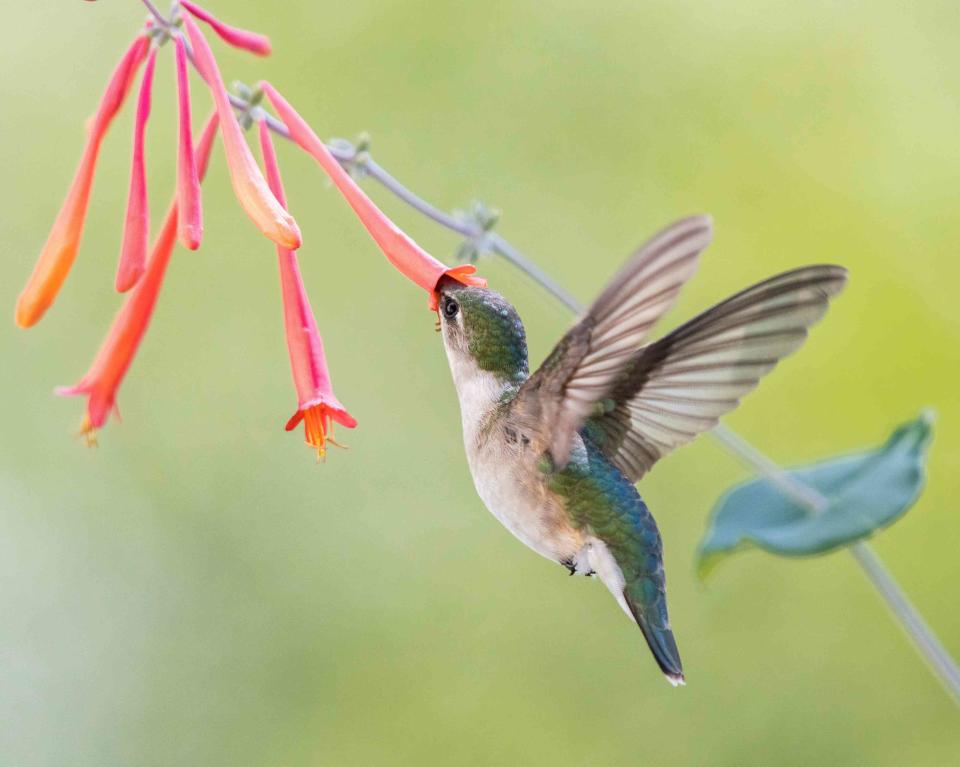
Ning Wang / Getty Images
Planting vines for hummingbirds will help lure these birds with plenty of nectar-filled flowers. Several easy-care annual and perennial vines offer the types of flowers that reliably attract hummers. Whether you only have room for a small vine or want to plant a huge, sprawling climber, this list has something for you. Plus, by selecting vines for hummingbirds that have different bloom times, you can ensure you'll keep the birds coming around all season long. Get tips from bird experts and garden designers to help you narrow down your choices.
Meet the Experts
Charles van Rees, Ph.D., conservation scientist and naturalist and founder of Gulo in Nature.
Amy Hovis, Principal/Owner of Eden Garden Design and Owner of Barton Springs Nursery.
Anna Ohler, pollinator-friendly and native gardens expert and owner of Bright Lane Gardens.
Types of Flowers to Attract Hummingbirds
Lots of flowering plants attract hummingbirds, but vines offer a few specific advantages. “Vining plants are an excellent way to get more flowers in your garden to attract hummingbirds while not taking up additional space,” says Charles van Rees, Ph.D., conservation scientist and naturalist and founder of Gulo in Nature. “They also allow the hummingbirds to feed more safely, since as the vines grow higher, they enable the hummingbird to eat at a greater height, further from ground predators.”
Flower color also plays an important role in what flowering plants are attractive to hummingbirds. Although red blossoms are commonly associated as a favorite of hummingbirds, there is plenty of nuance on what actually attracts hummingbirds, including the hummingbird species and the amount of nectar.
“While red is generally a safe bet for attracting hummingbirds, having a variety of flower colors in your garden can increase the chances of attracting a wider range of hummingbird species,” explains Amy Hovis, principal/owner of Eden Garden Design and owner of Barton Springs Nursery.
The shape of the flower is also influential. “Hummingbirds have long, thin beaks, so they are particularly drawn to tubular-shaped flowers that allow them to access the nectar with their long tongues,” says Hovis.
Experts recommend choosing native vines to attract hummingbirds over non-native species. As van Rees explains, “Native species are more likely to catch a hummingbird's eye because they are adapted to recognize these familiar plants in the wild.” Plus, natives are better adapted to your environment and climate, and are good food sources for native wildlife and pollinators besides hummingbirds.
Related: 22 Beautiful Garden Plans for Attracting Birds and Butterflies
Canary Creeper

Canary creeper (Tropaeolum peregrinum), a relative of nasturtium, is native to South America and thrives in hot climates. Although it’s not a native vine to the United States, hummingbirds will feast on the nectar. “Canary creeper has beautiful yellow flowers but does prefer summer heat year round,” says Anna Ohler, native gardening expert and owner of Bright Lane Gardens. It's perennial where winter temperatures stay above freezing, but grown as an annual elsewhere.
Season of Bloom: Early summer to fall
Growing Conditions: Full sun to part shade and well-drained, moist soil
Size: Climbs 8-15 feet
Zones: 9-10
Clematis
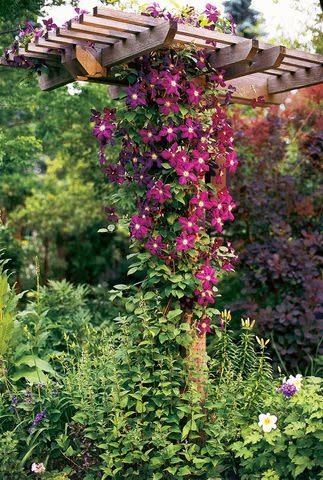
Better Homes and Gardens
An easy perennial vine to grow, clematis comes in single and double flowers. Clematis flowers range in color from blue, purple, white, pink, and more. Although the flower hue of purple and blue isn’t what you may assume hummingbirds will be attracted to, the birds do enjoy the nectar from clematis.
Season of Bloom: Summer and fall
Growing Conditions: Full sun to part shade and moist, well-drained soil
Size: Up to 10 feet tall
Zones: 4-8
Related: 14 Perennial Vines to Take Your Garden to New Heights
Coral Honeysuckle

An native plant found in the Southeast, coral honeysuckle (Lonicera sempervirens) is an excellent vine for hummingbirds. Coral honeysuckle also goes by the name trumpet honeysuckle because of its red, tubular flowers.
Season of Bloom: Spring to summer
Growing Conditions: Full sun to part shade and well-drained soil
Size: Climbs to 12 feet
Zones: 4-9
Cross Vine
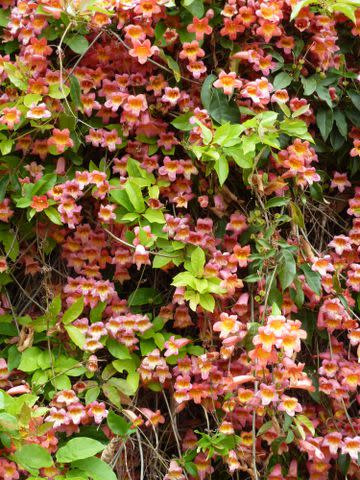
Denny Schrock
Want a vine that attracts hummingbirds and butterflies? Consider cross vine. With dense, evergreen foliage, crossvine is native to the Southeastern United States. “Cross vine is one of my favorites for Texas, a fast-growing vine that produces trumpet-shaped orange flowers [as well as] deeper red or yellow,” says Hovis.
Season of Bloom: Spring and summer
Growing Conditions: Full sun to part shade and well-drained, moist soil
Size: Up to 50 feet tall
Zones: 6-9
Cypress Vine

A quick-growing tropical plant, cypress vine (Ipomoea quamoclit) is native to Central America, Mexico, and the northern tropics of South America. Cypress vine has fern-like green leaves with spectacular tubular red blooms. Some varieties offer pink or white flowers. “Hummingbirds will flock to this vine, however, the blooms are fewer and further between than other vines,” says Ohler.
Season of Bloom: Summer to fall
Growing Conditions: Full sun and moist, well-drained soil
Size: Up to 15 feet tall
Zones: annual
Hyacinth Bean Vine
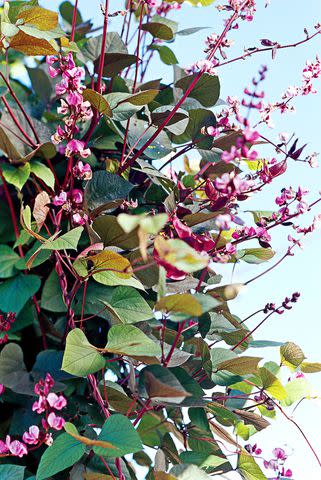
Hyacinth bean vines (Lablab purpureus) aren’t native to the United States; it’s native to various tropical regions on the African continent. However, hummingbirds will feed on this vine's flowers, which come in different hues, such as magenta, pink, and purple. These plants thrive in warm, tropical climates and won’t survive frosts, but can be grown as an annual in colder climates. The shoots and blooms are edible but avoid eating mature dried pods, which are toxic.
Season of Bloom: Summer to fall
Growing Conditions: Full sun and moist, well-drained soil
Size: Up to 20 feet tall
Zones: 9-11
Mandevilla

Mandevilla (Mandevilla boliviensis) is another non-native species that flourishes in hot climates and attracts hummingbirds. The slender, tubular flowers come in pink, red, and white, and some varieties offer a combination of hues. “Mandevilla vines are often grown in pots with trellises as an annual flower,” says Ohler. Be aware that this vine is toxic to humans and pets if eaten.
Season of Bloom: Summer until frost
Growing Conditions: Full sun to part shade and well-drained, moist soil
Size: Up to 10 feet tall
Zones: 10-11
Morning Glory

A quick-growing annual vine, morning glory (Ipomea purpurea) will climb up any structure they are planted next to. “The common morning glory has blue blossoms but the shape of the blossom is the bell-shape that hummingbirds look for,” says Ohler. “Morning glories do open in the morning only, which is perfect for hummingbirds as they tend to feed in the morning and then again in the evenings, usually about an hour before sundown.”
Season of Bloom: Summer to fall
Growing Conditions: Full sun in moist, well-drained soil
Size: Up to 10 feet tall
Zones: annual
Morning glories can reseed themselves prolifically and are considered invasive in some regions.
Orange Honeysuckle
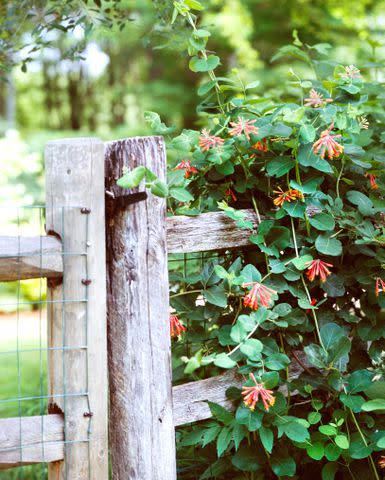
Alison Miksch
A native to the Northwest, orange honeysuckle (Lonicera ciliosa) is a perennial climbing plant that grows best in colder climates. These tubular blossoms range in color from bright red and orange hues as well as yellow and white. Hummingbirds will be drawn to your garden when these flowers are in bloom.
Season of Bloom: Spring
Growing Conditions: Full sun and moist, well-drained soil
Size: Up to 15 feet tall
Zones: 4-9
Passionflower
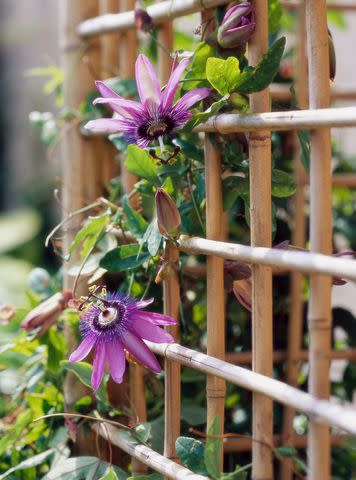
Passionflower (Passiflora spp.), also called passion vine, is native to the Southeastern United States. “Passionflower vine has crazy special, unique, purple flowers when in bloom that have a very tropical look to them,” says Hovis. “Certain varieties, such as the blue passionflower (Passiflora caerulea) or the red passionflower (Passiflora coccinea), attract hummingbirds with their nectar.”
Season of Bloom: Summer
Growing Conditions: Full sun to part shade and moist, well-drained soil
Size: Up to 8 feet tall
Zones: 5-9
Trumpet Vine
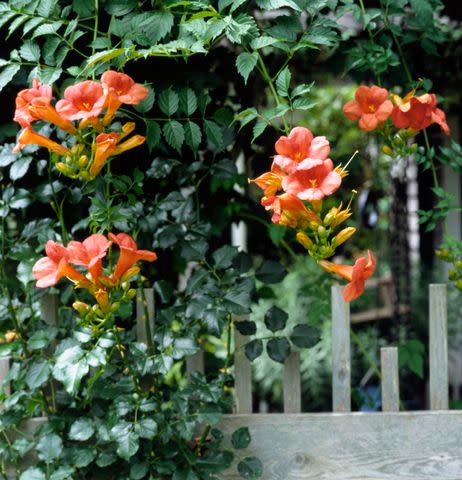
Trumpet vine (Campsis radicans) is also known as trumpet creeper and has bright green leaves and vibrant tube-shaped flowers in red, orange, and even yellow that bloom in midsummer. Native to the Southeastern United States, this vigorous growing vine is often referred to as the hummingbird vine because it’s a hummer magnet. “They love this bright orange vine that has large, bell-shaped blooms,” says Ohler.
Season of Bloom: Spring
Growing Conditions: Full sun to part shade and well-drained, moist soil
Size: Up to 40 feet tall
Zones: 4-9
Although trumpet vine is a native plant, it can become overly aggressive and weedy in some regions so check before planting.
Wisteria

A popular perennial vine, wisteria is often grown on porches and arbors where the fragrant purple flower clusters can dangle down. The flowers emit a scent that helps attract hummingbirds. The best type of wisteria for attracting hummingbirds is the American wisteria (Wisteria frutescens).
Season of Bloom: Spring
Growing Conditions: Full sun and moist, well-drained soil
Size: Up to 30 feet tall
Zones: 5-9
Chinese wisteria (Wisteria sinensis) is invasive in some regions of the United States, so check before planting.
Frequently Asked Questions
Do hummingbirds like to nest in vines?
The preferred nesting area of a hummingbird will depend on the species. In general, hummingbirds make nests in shrubs and bushes.
Which vines for hummingbirds also attract butterflies?
Butterflies are attracted to flowers with plenty of nectar, just like hummingbirds. But they also look for host plants where caterpillars will thrive. Some overlapping flowers that both pollinators like are trumpet vine, crossvine, passionflower, and coral honeysuckle.
Where’s the best place to grow a vine to attract hummingbirds?
Choosing where to place your vine is important for the success of the plant. The best place to grow a vine to attract hummingbirds is a place where the vine will receive sufficient sunlight and the preferred type of soil. Make sure hummingbirds can easily access the vines and their flowers.
For more Better Homes & Gardens news, make sure to sign up for our newsletter!
Read the original article on Better Homes & Gardens.

